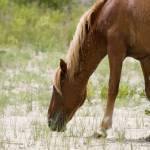Sand Colic in Horses

Sand colic, a form of impaction typically seen in horses that live in dry, sandy areas, occurs when the horse ingests sand. Horses with sand colic often show clinical signs of inappetence and abdominal pain, sometimes displayed as mild depression, looking at the flank or belly, pawing, rolling, or thrashing.
Diagnosis of sand colic is based on tests, clinical signs, and observation of the environment. A veterinarian might be able to hear sand in the horse’s intestine. Another common test involves checking the horse’s feces for sand, which will settle to the bottom when the manure is mixed with water and allowed to sit for several minutes. Sand can also be visible in the gastrointestinal tract via radiography or ultrasonography.
Horses with sand colic are often treated with mineral oil for its laxative effect or given a psyllium-based product in the hope that it will stimulate intestinal motility and agglutinate the sand, making it stick together for easier clearance. However, research has shown psyllium to be relatively inefficient at removing sand from the intestine, so its use, while not harmful, may not be completely efficacious. Surgery might also be required in some cases.
Horse owners in sandy areas should take steps to prevent sand colic in their horses. Management steps to reduce the risk of sand colic might include feeding horses on solid surfaces, such as rubber mats, and ensuring horses have plenty of forage (such as hay or chaff) in their diets to prevent them from seeking out sand or ingesting sand while grazing overtaxed pastures.








